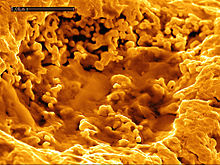| Cupriavidus metallidurans | |
|---|---|
| Scientific classification | |
| Domain: | Bacteria |
| Phylum: | Pseudomonadota |
| Class: | Betaproteobacteria |
| Order: | Burkholderiales |
| Family: | Burkholderiaceae |
| Genus: | Cupriavidus |
| Binomial name | |
| Cupriavidus metallidurans (Goris et al. 2001) Vandamme and Coenye 2004 | |
| Type strain | |
| ATCC 43123, aka CH34 | |
| Synonyms | |
(Not distinguished from Ralstonia eutropha until 2001.) | |
Cupriavidus metallidurans is a non-spore-forming, Gram-negative bacterium which is adapted to survive several forms of heavy metal stress.
As a model and industrial system
Cupriavidus metallidurans is a bacterial species that belongs to the same family as Ralstonia solanacearum, a plant pathogen.
This species is of ecological and industrial importance, as its relatives dominate mesophilic environments contaminated with heavy metals. C. metallidurans is used in the industrial sector for both heavy metal remediation and sensing.
This aerobic chemolithoautotroph is capable of growing in a mineral salts environment with H2, O2, and CO2 without an organic carbon source. Its energy-providing subsystem is composed of only the hydrogenase, the respiratory chain, and the F1F0-ATPase, which remain separate from the anabolic subsystems.
C. metallidurans can also degrade xenobiotics in conditions with high levels of heavy metals.
Strain CH34 has adapted to these harsh conditions through multiple heavy-metal resistance systems, encoded by the two indigenous megaplasmids, pMOL28 and pMOL30, on its chromosome(s).
Ecology

C. metallidurans plays a vital role, together with Delftia acidovorans, in the formation of gold nuggets. It precipitates metallic gold from a solution of gold(III) chloride, a compound highly toxic to most other microorganisms.
As a pathogen
A case of a 74 year old man infected with Cupriavidus metallidurans has been documented, possibly raising concerns about the safety of using the bacteria for industrial purposes.
References
- Vandamme, P.; T. Coeyne (June 18, 2004). "Taxonomy of the genus Cupriavidus: a tale of lost and found". International Journal of Systematic and Evolutionary Microbiology. 54 (Pt 6): 2285–2289. doi:10.1099/ijs.0.63247-0. PMID 15545472.
- ^ Goris, J.; et al. (2001). "Classification of metal-resistant bacteria from industrial biotopes as Ralstonia campinensis sp. nov., Ralstonia metallidurans sp. nov. and Ralstonia basilensis Steinle et al. 1998 emend". Int J Syst Evol Microbiol. 51 (Pt 5): 1773–1782. doi:10.1099/00207713-51-5-1773. PMID 11594608.
- ^ Nies, DH (1999). "Microbial heavy metal resistance". Appl Microbiol Biotechnol. 51 (6): 730–750. doi:10.1007/s002530051457. PMID 10422221. S2CID 6675586.
- ^ Nies, DH (2000). "Heavy metal resistant bacteria as extremophiles: molecular physiology and biotechnological use of Ralstonia spec. CH34". Extremophiles. 4 (2): 77–82. doi:10.1007/s007920050140. PMID 10805561. S2CID 11156112.
- Ryan, Michael P.; Adley, Catherine C. (2011-09-01). "Specific PCR to identify the heavy-metal-resistant bacterium Cupriavidus metallidurans". Journal of Industrial Microbiology & Biotechnology. 38 (9): 1613–1615. doi:10.1007/s10295-011-1011-y. ISSN 1476-5535. PMID 21720772. S2CID 33552248.
- Salanoubat M.; et al. (2002). "Genome sequence of the plant pathogen Ralstonia solanacearum". Nature. 415 (6871): 497–502. doi:10.1038/415497a. PMID 11823852.
- Diels, L.; Q. Dong; D. van der Lelie; W. Baeyens; M. Mergeay (1995). "The czc operon of Alcaligenes eutrophus CH34: from resistance mechanism to the removal of heavy metals". Journal of Industrial Microbiology. 14 (2): 142–153. doi:10.1007/BF01569896. PMID 7766206. S2CID 29272445.
- Mergeay, M.; D. Nies; H.G. Schlegel; J. Gerits; P. Charles; F. van Gijsegem (1985). "Alcaligenes eutrophus CH34 is a facultative chemolithotroph with plasmid-bound resistance to heavy metals". Journal of Bacteriology. 162 (1): 328–334. doi:10.1128/JB.162.1.328-334.1985. PMC 218993. PMID 3884593.
- Springael, D.; L. Diels; L. Hooyberghs; S. Kreps; M. Mergeay (1993). "Construction and characterization of heavy metal resistant haloaromatic-degrading Alcaligenes eutrophus strains". Appl Environ Microbiol. 59 (1): 334–339. doi:10.1128/AEM.59.1.334-339.1993. PMC 202101. PMID 8439161.
- Monchy, S.; M.A. Benotmane; P. Janssen; T. Vallaeys; S. Taghavi; D. van der Lelie; M. Mergeay (October 2007). "Plasmids pMOL28 and pMOL30 of Cupriavidus metallidurans are specialized in the maximal viable response to heavy metals". Journal of Bacteriology. 189 (20): 7417–7425. doi:10.1128/JB.00375-07. PMC 2168447. PMID 17675385.
- Reith, Frank; Stephen L. Rogers; D. C. McPhail; Daryl Webb (July 14, 2006). "Biomineralization of Gold: Biofilms on Bacterioform Gold". Science. 313 (5784): 233–236. Bibcode:2006Sci...313..233R. doi:10.1126/science.1125878. hdl:1885/28682. PMID 16840703. S2CID 32848104.
- Superman-Strength Bacteria Produce 24-Karat Gold
- The bacteria that turns toxic chemicals into pure gold
- Langevin, Stéphanie; Vincelette, Jean; Bekal, Sadjia; Gaudreau, Christiane (February 2011). "First Case of Invasive Human Infection Caused by Cupriavidus metallidurans". Journal of Clinical Microbiology. 49 (2): 744–745. doi:10.1128/JCM.01947-10. ISSN 0095-1137. PMC 3043494. PMID 21106795.
External links
- Article at Live Science
- Type strain of Cupriavidus metallidurans at BacDive - the Bacterial Diversity Metadatabase
| Taxon identifiers | |
|---|---|
| Cupriavidus metallidurans | |